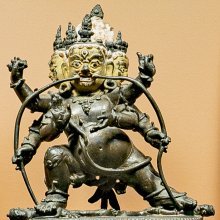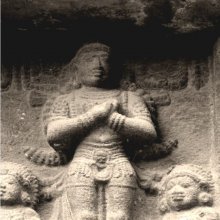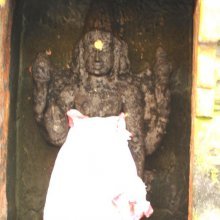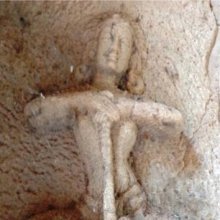Hip: 2 definitions
Introduction:
Hip means something in Hinduism, Sanskrit. If you want to know the exact meaning, history, etymology or English translation of this term then check out the descriptions on this page. Add your comment or reference to a book if you want to contribute to this summary article.
Images (photo gallery)
(+13 more images available)
In Hinduism
Vastushastra (architecture)
Source: Shodhganga: Elements of Art and Architecture in the Trtiyakhanda of the Visnudharmottarapurana (vastu)The Hip part of the Temple (in ancient Indian architecture) is denoted by Sanskrit term Kaṭi, according to the Viṣṇudharmottarapurāṇa, an ancient Sanskrit text which (being encyclopedic in nature) deals with a variety of cultural topics such as arts, architecture, music, grammar and astronomy.—Kaṭi means the Hip part of a building. According to the Viṣṇudharmottarapurāṇa, kaṭi i.e., the hip part of the temple should be half of the entire height of the temple. But according to the Bṛhatsaṃhitā, the hip portion of a temple should be equal to one third of its height. Again, the Matsyapurāṇa also keeps its view point in the same spirit with that in the Bṛhatsaṃhitā. [...]

Vastushastra (वास्तुशास्त्र, vāstuśāstra) refers to the ancient Indian science (shastra) of architecture (vastu), dealing with topics such architecture, sculpture, town-building, fort building and various other constructions. Vastu also deals with the philosophy of the architectural relation with the cosmic universe.
Shilpashastra (iconography)
Source: Shodhganga: Elements of Art and Architecture in the Trtiyakhanda of the Visnudharmottarapurana (shilpa)The Hips are denoted by the Sanskrit term Kaṭi, and represents one of the various body parts whose Measurements should follow the principles of ancient Indian Painting (citra), according to the Viṣṇudharmottarapurāṇa, an ancient Sanskrit text which (being encyclopedic in nature) deals with a variety of cultural topics such as arts, architecture, music, grammar and astronomy.—In the third part of the Viṣṇudharmottarapurāṇa, chapters 35th to 43rd are dedicated to the Painting of different portraits of different kinds of men and women. The measurement of almost all the body parts that should be maintained in a picture have been presented here. For example, the Hip (kaṭi) should be 12 aṅgulas.

Shilpashastra (शिल्पशास्त्र, śilpaśāstra) represents the ancient Indian science (shastra) of creative arts (shilpa) such as sculpture, iconography and painting. Closely related to Vastushastra (architecture), they often share the same literature.
See also (Relevant definitions)
Starts with (+27): Hiphajata, Hiphajati, Hiphja, Hipi-kumbaung, Hippa, Hippadike, Hippal verali, Hippalanerale, Hippali, Hippali naerala, Hippaliberu, Hippalike, Hippalimula, Hippana, Hippanama, Hippanerile, Hipparare, Hipparike, Hippatar, Hippe.
Ends with (+46): Abhikship, Abhisamkship, Abhivikship, Adhikship, Adhip, Akship, Ancestor Worship, Apakship, Atikship, Avakship, Cahip, Calendrical worship, Chip, Coach-whip, Companionship, Daily worship, Devils whip, Dhipadhip, Elephant hip, Fire-worship.
Full-text (+546): Kati, Shroni, Nitamba, Jaghana, Shroniphalaka, Vararoha, Mekhalapada, Kalatra, Katishirshaka, Kata, Autsangika, Shronitata, Katitata, Sushroni, Strikati, Vipulajaghana, Kulha, Katika, Kancipada, Katitra.
Relevant text
Search found 131 books and stories containing Hip; (plurals include: Hips). You can also click to the full overview containing English textual excerpts. Below are direct links for the most relevant articles:
Vinaya (3): The Cullavagga (by T. W. Rhys Davids)
Cullavagga, Khandaka 5, Chapter 30 < [Khandaka 5 - On the Daily Life of the Bhikkhus]
Cullavagga, Khandaka 10, Chapter 16 < [Khandaka 10 - On the Duties of Bhikkhunis]
Manusmriti with the Commentary of Medhatithi (by Ganganatha Jha)
Verse 8.281 < [Section XLII - Assaults]
Verse 8.124 < [Section XXI - Corporal Punishment]
Vinaya Pitaka (2): Bhikkhuni-vibhanga (the analysis of Nun’ rules) (by I. B. Horner)
The Agni Purana (by N. Gangadharan)
Chapter 45 - Characteristics of pedestals and details relating to images
Chapter 252 - The mode of wielding the swords, maces etc.
Chapter 244 - The characteristic features of Women (strī-lakṣaṇa)
Indian Medicinal Plants (by Kanhoba Ranchoddas Kirtikar)
50. Berberis aristata, D.C. < [Berberidaceae (barberry family)]
Pallava period (Social and Cultural History) (by S. Krishnamurthy)
Dressing style of Upper-class men < [Chapter 4 - Material Culture of the People]
Waist Ornaments (Introduction) < [Chapter 4 - Material Culture of the People]
Personal Ornaments of Men and Women < [Chapter 4 - Material Culture of the People]
Related products
(+3 more products available)











